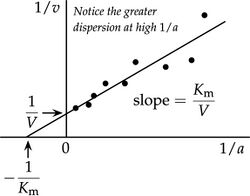| Display title | Lineweaver–Burk plot |
| Default sort key | Lineweaver-Burk plot |
| Page length (in bytes) | 7,867 |
| Namespace ID | 0 |
| Page ID | 184551 |
| Page content language | en - English |
| Page content model | wikitext |
| Indexing by robots | Allowed |
| Number of redirects to this page | 0 |
| Counted as a content page | Yes |
| Page image |  |
| HandWiki item ID | None |
| Edit | Allow all users (infinite) |
| Move | Allow all users (infinite) |
| Page creator | imported>Gametune |
| Date of page creation | 23:21, 6 February 2024 |
| Latest editor | imported>Gametune |
| Date of latest edit | 23:21, 6 February 2024 |
| Total number of edits | 1 |
| Recent number of edits (within past 90 days) | 0 |
| Recent number of distinct authors | 0 |
Description | Content |
Article description: (description)
This attribute controls the content of the description and og:description elements. | In biochemistry, the Lineweaver–Burk plot (or double reciprocal plot) is a graphical representation of the Michaelis–Menten equation of enzyme kinetics, described by Hans Lineweaver and Dean Burk in 1934.
The double reciprocal plot distorts the error structure of the data, and is therefore not the most... |

